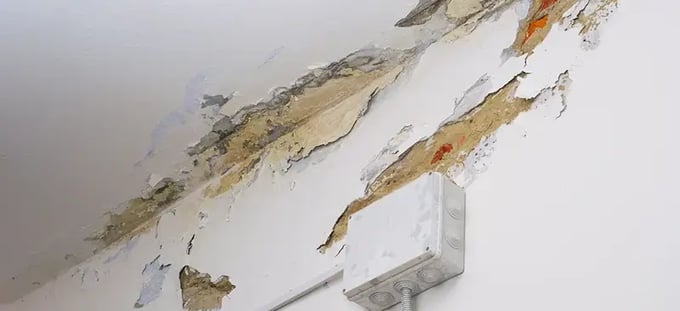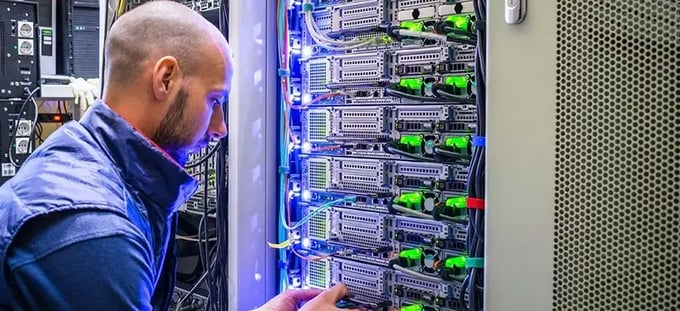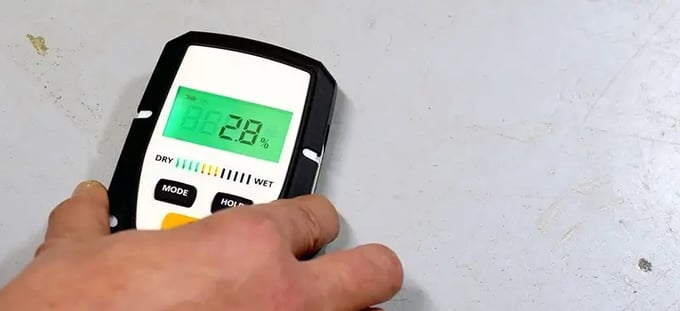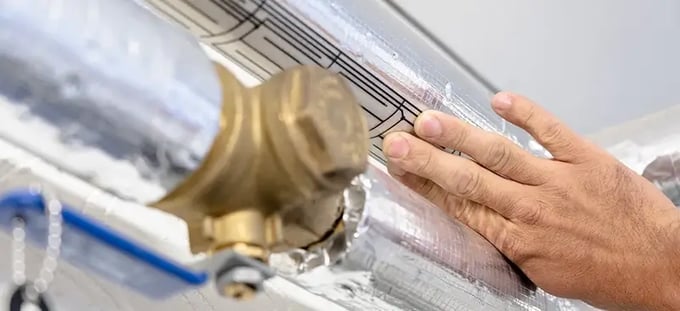When thinking about commercial buildings, the terms ‘larger-scale’, ‘more expensive’ and ‘more stakeholders’ may come to mind. The impact of water leaks can be devastating. On average, commercial buildings suffer a loss of US$1.4M, while domestic homes suffer a loss of US$4K. These qualities explain why the impact is so severe.
Water leaks are common in commercial buildings, especially high rises. They can be caused by cracked humidity vents or damaged roof flashing. Serious events can have far-reaching consequences for businesses. In some cases, they may be forced to shut down for up to six months, damaging their reputation.
Water-sensing devices are used to detect water leaks before they cause catastrophic damage. These devices can be installed in a building or used for inspection. There is now a consideration required for commercial buildings.
This is because they are varied and have different leak types. Despite the many sensor choices, this consideration must be taken into account. This will have an effect on features like installation and form factors. There is no purpose in installing the best sensors if they cannot be accessed for recalibration.
Therefore, in this post, we explore the key weaknesses of commercial buildings and what current sensing devices are offering. This will explain what we believe are the key features that should be in commercial water leak sensors. Then finally, we present our LoRaWAN water leak detection system that effectively de-risks potential water damage.
Commercial buildings: More appliances, more pipes, more weak points

Roofs
Roofing, as an integral part of commercial buildings, can be the most problematic, in the US alone, more than US$12B is spent annually on repairing and recovering roofs. Particularly on high-rise buildings, roofs are exposed to more extreme temperatures, wind speeds, and precipitation that can damage roofing layers and vulnerable areas such as around flashing and skylights over time.
Flat roofs are popular for commercial buildings. However, they have worse drainage properties. This can result in damage such as ponding and blistering being more apparent.
Roofs have multiple layers. If water gets through the weatherproof membrane, it can cause permanent damage to the wooden boards and insulation. This can also affect the structure underneath.
External features: Windows, balconies, and guttering
Externally, commercial buildings often have more windows, balconies, and gutters. This opens up the potential for water intrusion if these parts are not properly sealed. Similar to roofing, this can warp inner drywall but consistent leaks can corrode rebar, sabotaging concrete structures.
Internal water sources: Toilets, faucets, and plumbed-in appliances
As well as more external features, more occupants or equipment mean more toilets, faucets and plumbed-in appliances. Although these appliances by themselves can be easy to repair, detecting signs of leaks can be difficult, especially at the scale of commercial buildings. These types of leaks can also start very subtly but can deteriorate suddenly if not maintained.

Pipes and HVAC networks
What is becoming more apparent due to COVID-19 is that buildings have had lower occupancy rates meaning that plumbing systems have been drained and left full of oxygen. This creates an optimum environment for corrosion, so when recommissioned, this can lead to unexpected issues in the pipework. This phenomenon is likely to happen in HVAC networks. These networks require a lot of maintenance due to different temperatures, moisture levels, and contaminants.
Supply and sewer lines are another weak point susceptible to pipe bursts from cold weather, corrosion and adverse pressure. Pipe leaks may also be harder to detect as they can be underground.
Unwanted water can damage a building in many ways. Monitoring water damage by eye is not enough. Water leaks are unpredictable and will become more severe in a commercial building.

The indirect destruction of water leaks
A building’s weak points will vary depending on the building type, whether a hospital, data center, high-rise office, or storage warehouse; however, the potential costs could still be huge for whichever case.
For example, one failed pressure release valve caused major damage in a high-rise office. The water damage cost US$6.5M and the repairs took six months. Damaged offices, elevators, and electricals had to be fixed.
Recovering the building’s structure can salvage costs, however, for buildings, such as data centers, companies can permanently lose valuable assets. Downtime for critical servers costs around US$350K per hour. Additionally, losing sensitive data can destroy valuable business relationships. Hospitals are similarly critical buildings with valuable equipment and machinery but with the added factor of patients whose lives could be at risk.
Early detection of water leaks can reduce the high risks associated with them. This may lead to more insurance policies specifically for commercial buildings.

Sensor solutions
For commercial buildings, there are many leak detection services hired to locate and specify the characteristics of a leak. These professional methods are usually for more serious leaks in inaccessible areas such as an underground supply line. Examples used include acoustic sensors, thermal imaging cameras and tracer gas to manually investigate leak types. These manual methods can be very informative after a leak is detected however, are slow, expensive and may require periods of downtime.
Water leak sensors, on the other hand, detect water leaks automatically, taking a more proactive approach. These sensors come in three main forms for commercial buildings: flow meters, spot sensors and cable sensors.
Firstly, flow meters can be installed within pipes and plumbing networks to detect changes in flow, velocity, pressure or vibration so facility managers can be notified of any monitored water damage. These can also be set up to automatically shut off water supplies. The disadvantage of these is that for large multi-facility buildings, leaks are not located just stopped. These also do not detect leaks caused from outside the building which are just as important.
Secondly, there are spot sensors, also known as flood sensors. These sensors are palm-sized and have multiple probes. They are placed in areas that are prone to leaks. Once the probes conduct water, this is communicated to prompt inspection in this area.
This can pinpoint where the leak is originating. However, spot sensors often have a fixed shape, limiting the ability to sense on hard, flat surfaces.
Lastly, sensor cables are flexible alternatives to spot sensors meaning they can be installed around pipes or at the edge of rooms. Another benefit is that they can cover large spans of areas that suit commercial settings with large roofs or floorings.
Automatic IoT water leakage sensors have more advantages than just detecting leaks. Data analytics, knowledge of when to service certain areas, and improved insurance terms are all included.

Future considerations for the optimum water leak sensor
Although deploying these smart water leak detectors has the potential to reduce huge costs, how can their effectiveness be guaranteed? Careful consideration of the sensor’s location, accessibility and communication abilities are key in a successful leak detection setup.
Potential leak points can vary significantly. This means a spot sensor that works in an office kitchen may not be suitable for an expansive IT cooling system. It may therefore be difficult for building contractors or owners to know exactly what solution to choose.
At LAIIER, we have considered the importance of adaptability. To do this, we have created a series of thin, sticker-like sensors. These sensors can accurately detect changes in a wide range of environments. This can cover wide areas or even be trimmed to fit in tight plumbing networks.
The placement of the sensor is very important for detecting a leak early. It can be tricky to identify the exact location. LAIIER's design and sensing technology make our sensors cost-effective and easily expandable. This allows us to convert large areas into smart water sensors without drawing attention.
This removes the need to pinpoint high-risk areas. LAIIER’s sensors can also communicate where specifically on the sensor it was triggered and to a more accurate degree than cable sensors. This makes it easier to identify the cause so only damaged parts need to be repaired.
During the operation phase, access to the sensor is vital as this will allow for maintenance and replacement if needed. LAIIER's sensors enable remote connectivity. They communicate sensor measurements and status, eliminating the need for facility managers to manually inspect leak monitors.
Our LAIIER Cloud platform on our LoRaWAN leak detectors furthermore allows for wireless and power-efficient communication. Extended battery life, automatic communication and scalability are all essential qualities seen in upcoming IoT water management systems.
Finally, leak detector readings can be enhanced by having additional temperature and/or humidity sensors. This can form a larger picture of whether corrosion, as the main detriment of pipes, is taking place.
There is more to consider than just the sensor
It is conclusive that a lot is at stake for commercial buildings highlighting how important the water leak sensing opportunity is. Early detection and data availability help stakeholders stay informed and in control of their properties.
This was not always the situation. Taking a proactive stance can help transform insurance provider attitudes. They may become more confident in covering water-related policies.
The process does not end with a sensing solution. Sensors must be placed strategically to detect various leak types on different surfaces. They must also communicate with the facility manager efficiently. Meeting these conditions is especially important in commercial buildings where water leaks can be more destructive.
LAIIER has placed the essential requirements at the forefront when creating our LoRaWAN® water leak detector systems. We have incorporated adaptable, printed sensors.